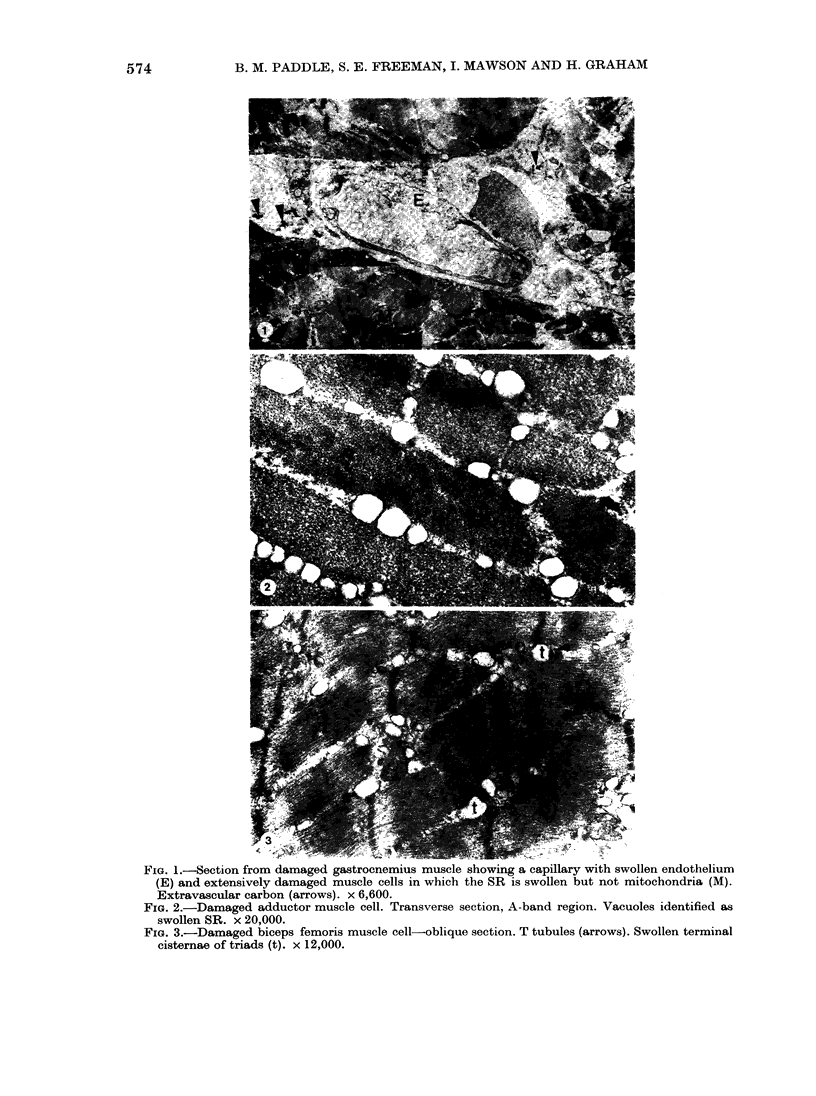Abstract
A study was made of damage to skeletal muscle caused by a high-velocity rifle bullet. Such damage extends peripherally from the permanent wound cavity and is focal in nature. A fine-structure investigation of this region suggests that some components of the muscle are more susceptible to the wounding process than others. The sarcoplasmic reticulum appeared most sensitive and areas as far as 3 cm from the wound cavity frequently showed gross vacuolization. Mitochrondrial damage was seen, but only in areas where there was also damage to myofibrils and the microvasculature. Focal capillary leakage up to 3 cm from the wound cavity was demonstrated in an earlier study by the use of a fluorescein-labelled dextran (Paddle and Freeman, 1979). This finding was confirmed. A possible correlate at the fine structural level was swelling of te capillary endothelial cells, which occurred in the absence of other signs of microvascular damage. Damage to the endothelial junctions was not observed, even in severely damaged tissue. Intravascular colloidal carbon escaped into the extravascular space only when the microvasculature was fractured. The relationship of these findings to macroscopic damage is discussed.
Full text
PDF











Images in this article
Selected References
These references are in PubMed. This may not be the complete list of references from this article.
- Brånemark P. I., Ekholm R., Lindhe J. Colloidal carbon used for identification of vascular permeability. Med Exp Int J Exp Med. 1968;18(3):139–150. doi: 10.1159/000137149. [DOI] [PubMed] [Google Scholar]
- Charters A. C., 3rd, Charters A. C. Wounding mechanism of very high velocity projectiles. J Trauma. 1976 Jun;16(6):464–470. doi: 10.1097/00005373-197606000-00005. [DOI] [PubMed] [Google Scholar]
- Cotran R. S., Suter E. R., Majno G. The use of colloidal carbon as a tracer for vascular injury. A review. Vasc Dis. 1967 Apr;4(2):107–127. [PubMed] [Google Scholar]
- Dahlgren B., Berlin R., Janzon B., Nordström G., Nylöf U., Rybeck B., Schantz B., Seeman T. The extent of muscle tissue damage following missile trauma one, six and twelve hours after the infliction of trauma, studied by the current method of debridement. Acta Chir Scand Suppl. 1979;489:137–144. [PubMed] [Google Scholar]
- Davey D. F. The effect of fixative tonicity on the myosin filament lattice volume of frog muscle fixed following exposure to normal or hypertonic Ringer. Histochem J. 1973 Jan;5(1):87–104. doi: 10.1007/BF01012048. [DOI] [PubMed] [Google Scholar]
- Gauthier G. F. On the relationship of ultrastructural and cytochemical features of color in mammalian skeletal muscle. Z Zellforsch Mikrosk Anat. 1969;95(3):462–482. doi: 10.1007/BF00995217. [DOI] [PubMed] [Google Scholar]
- Gonzalez-Serratos H., Somlyo A. V., McClellan G., Shuman H., Borrero L. M., Somlyo A. P. Composition of vacuoles and sarcoplasmic reticulum in fatigued muscle: electron probe analysis. Proc Natl Acad Sci U S A. 1978 Mar;75(3):1329–1333. doi: 10.1073/pnas.75.3.1329. [DOI] [PMC free article] [PubMed] [Google Scholar]
- HOPKINSON D. A., WATTS J. C. Studies in experimental missile injuries of skeletal muscle. Proc R Soc Med. 1963 Jun;56:461–468. doi: 10.1177/003591576305600606. [DOI] [PMC free article] [PubMed] [Google Scholar]
- Jennings R. B., Ganote C. E. Structural changes in myocardium during acute ischemia. Circ Res. 1974 Sep;35 (Suppl 3):156–172. [PubMed] [Google Scholar]
- KRAUSS M. Studies in wound ballistics: temporary cavity effects in soft tissues. Mil Med. 1957 Oct;121(4):221–231. [PubMed] [Google Scholar]
- Lewis D. H., Rybeck B., Sandegård J., Seeman T., Zachrisson B. E. Circulatory disturbances following missile wounding of soft tissue. Acta Radiol Diagn (Stockh) 1975 Sep;16(5):481–493. doi: 10.1177/028418517501600506. [DOI] [PubMed] [Google Scholar]
- REYNOLDS E. S. The use of lead citrate at high pH as an electron-opaque stain in electron microscopy. J Cell Biol. 1963 Apr;17:208–212. doi: 10.1083/jcb.17.1.208. [DOI] [PMC free article] [PubMed] [Google Scholar]
- Rybeck B., Lewis D. H., Sandegård J., Seeman T. Cardiovascular effects of venous blood from missile wounds. Eur Surg Res. 1975;7(4-5):193–204. doi: 10.1159/000127805. [DOI] [PubMed] [Google Scholar]
- Sanderson R. A., Foley R. K., McIvor G. W., Kirkaldy-Willis W. H. Histological response on skeletal muscle to ischemia. Clin Orthop Relat Res. 1975 Nov-Dec;(113):27–35. doi: 10.1097/00003086-197511000-00005. [DOI] [PubMed] [Google Scholar]
- TRUMP B. F., SMUCKLER E. A., BENDITT E. P. A method for staining epoxy sections for light microscopy. J Ultrastruct Res. 1961 Aug;5:343–348. doi: 10.1016/s0022-5320(61)80011-7. [DOI] [PubMed] [Google Scholar]
- Whelan T. J., Jr, Burkhalter W. E., Gomez A. Management of war wounds. Adv Surg. 1968;3:227–350. [PubMed] [Google Scholar]
- Ziervogel J. F. A study of the muscle damage caused by the 7.62 NATO rifle. Acta Chir Scand Suppl. 1979;489:131–135. [PubMed] [Google Scholar]











